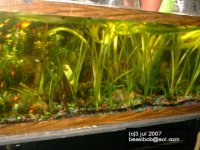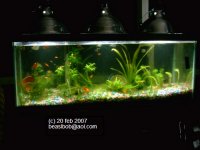BTW, just to put everything into perspective, specially if you're following this without having read the original EI article. Tom advocates the following nutrient levels:
CO2: 20-30ppm
NO3: 5-10ppm
K+: 20-30ppm
PO4: 0.4-1.0ppm
Fe: .5ppm or above
These are quite normal levels for fast growing tanks, actually they are conservative based on today's standards for such tanks. The main difference is he "resets" the tank back to "close-to-tap-water" levels each week allowing one to dose for example the full 5-10ppm of nitrate without having to worry about what's left over from previous doses. The tollerances for FW planted tanks are quite large and well within most people's tap water levels. My tap water for example contains 5ppm nitrate, that would bring me to 15-20ppm which is fine, if it hadn't been fine, I'd have to lower the amount dosed, but I'd still be able to dose it repeatedly each week without testing once I have established the required amount...
That along with the addition of PO4 was basically the only "new" things Tom elaborated on from the PMDD paper. It was becoming quite evident that PMDD was not working as well under strong lighting and CO2 while this approach did, wasteful as it may be.
I guess you could compare it to doing water changes in a reef tank to replenish traces and such Vs having to test for all of them and dose them individually as needed.
CO2: 20-30ppm
NO3: 5-10ppm
K+: 20-30ppm
PO4: 0.4-1.0ppm
Fe: .5ppm or above
These are quite normal levels for fast growing tanks, actually they are conservative based on today's standards for such tanks. The main difference is he "resets" the tank back to "close-to-tap-water" levels each week allowing one to dose for example the full 5-10ppm of nitrate without having to worry about what's left over from previous doses. The tollerances for FW planted tanks are quite large and well within most people's tap water levels. My tap water for example contains 5ppm nitrate, that would bring me to 15-20ppm which is fine, if it hadn't been fine, I'd have to lower the amount dosed, but I'd still be able to dose it repeatedly each week without testing once I have established the required amount...
That along with the addition of PO4 was basically the only "new" things Tom elaborated on from the PMDD paper. It was becoming quite evident that PMDD was not working as well under strong lighting and CO2 while this approach did, wasteful as it may be.
I guess you could compare it to doing water changes in a reef tank to replenish traces and such Vs having to test for all of them and dose them individually as needed.







